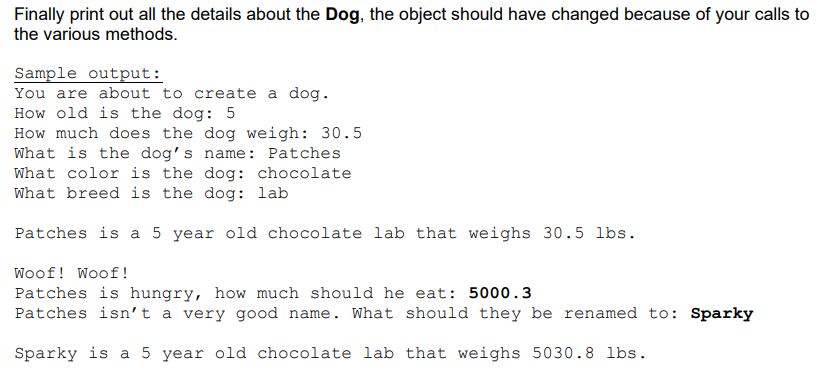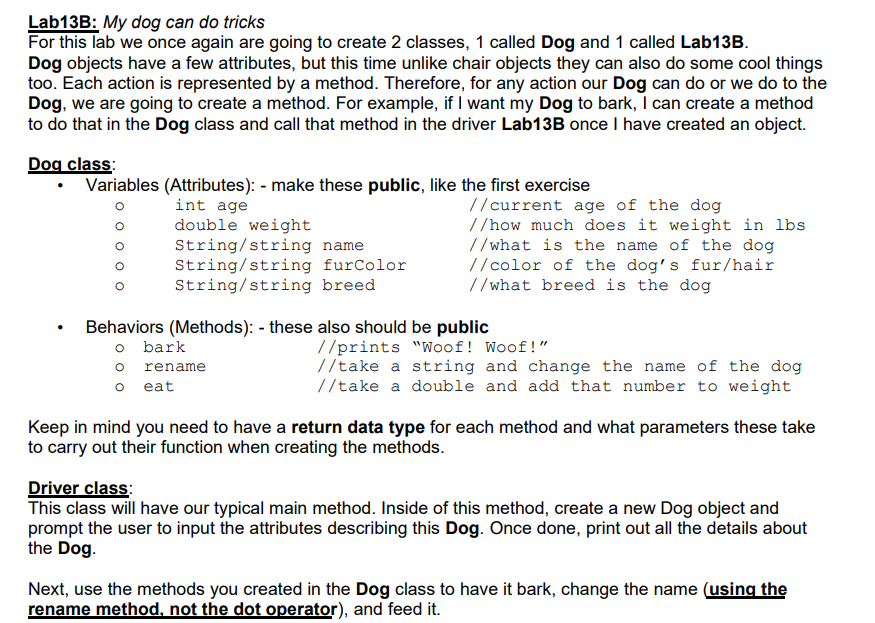For this lab we once again are going to create 2 classes, 1 called Dog and 1 called Lab13B. Dog objects have a few attributes, but this time unlike chair objects they can also do some cool things too. Each action is represented by a method. Therefore, for any action our Dog can do or we do to the Dog, we are going to create a method. For example, if I want my Dog to bark, I can create a method to do that in the Dog class and call that method in the driver Lab13B once I have created an object. Dog class: • Variables (Attributes): - make these public, like the first exercise int age double weight String/string name String/string furColor String/string breed //current age of the dog //how much does it weight in lbs //what is the name of the dog //color of the dog's fur/hair //what breed is the dog Behaviors (Methods): - these also should be public o bark o rename o eat //prints "Woof! Woof!" //take a string and change the name of the dog //take a double and add that number to weight Keep in mind you need to have a return data type for each method and what parameters these take to carry out their function when creating the methods. Driver class: This class will have our typical main method. Inside of this method, create a new Dog object and prompt the user to input the attributes describing this Dog. Once done, print out all the details about the Dog.
For this lab we once again are going to create 2 classes, 1 called Dog and 1 called Lab13B. Dog objects have a few attributes, but this time unlike chair objects they can also do some cool things too. Each action is represented by a method. Therefore, for any action our Dog can do or we do to the Dog, we are going to create a method. For example, if I want my Dog to bark, I can create a method to do that in the Dog class and call that method in the driver Lab13B once I have created an object. Dog class: • Variables (Attributes): - make these public, like the first exercise int age double weight String/string name String/string furColor String/string breed //current age of the dog //how much does it weight in lbs //what is the name of the dog //color of the dog's fur/hair //what breed is the dog Behaviors (Methods): - these also should be public o bark o rename o eat //prints "Woof! Woof!" //take a string and change the name of the dog //take a double and add that number to weight Keep in mind you need to have a return data type for each method and what parameters these take to carry out their function when creating the methods. Driver class: This class will have our typical main method. Inside of this method, create a new Dog object and prompt the user to input the attributes describing this Dog. Once done, print out all the details about the Dog.
Chapter11: Advanced Inheritance Concepts
Section: Chapter Questions
Problem 2PE
Related questions
Question
language is c++
sample output included with user input in bold

Transcribed Image Text:Finally print out all the details about the Dog, the object should have changed because of your calls to
the various methods.
Sample output:
You are about to create a dog.
How old is the dog: 5
How much does the dog weigh: 30.5
What is the dog's name: Patches
What color is the dog: chocolate
What breed is the dog: lab
Patches is a 5 year old chocolate lab that weighs 30.5 lbs.
Woof! Woof!
Patches is hungry, how much should he eat: 5000.3
Patches isn't a very good name. What should they be renamed to: Sparky
Sparky is a 5 year old chocolate lab that weighs 5030.8 lbs.

Transcribed Image Text:Lab13B: My dog can do tricks
For this lab we once again are going to create 2 classes, 1 called Dog and 1 called Lab13B.
Dog objects have a few attributes, but this time unlike chair objects they can also do some cool things
too. Each action is represented by a method. Therefore, for any action our Dog can do or we do to the
Dog, we are going to create a method. For example, if I want my Dog to bark, I can create a method
to do that in the Dog class and call that method in the driver Lab13B once I have created an object.
Dog class:
• Variables (Attributes): - make these public, like the first exercise
int age
double weight
String/string name
String/string furColor
String/string breed
//current age of the dog
//how much does it weight in lbs
//what is the name of the dog
//color of the dog's fur/hair
//what breed is the dog
Behaviors (Methods): - these also should be public
o bark
o rename
o eat
//prints "Woof! Woof!"
//take a string and change the name of the dog
//take a double and add that number to weight
Keep in mind you need to have a return data type for each method and what parameters these take
to carry out their function when creating the methods.
Driver class:
This class will have our typical main method. Inside of this method, create a new Dog object and
prompt the user to input the attributes describing this Dog. Once done, print out all the details about
the Dog.
Next, use the methods you created in the Dog class to have it bark, change the name (using the
rename method, not the dot operator), and feed it.
Expert Solution
This question has been solved!
Explore an expertly crafted, step-by-step solution for a thorough understanding of key concepts.
Step by step
Solved in 2 steps with 5 images

Knowledge Booster
Learn more about
Need a deep-dive on the concept behind this application? Look no further. Learn more about this topic, computer-science and related others by exploring similar questions and additional content below.Recommended textbooks for you

EBK JAVA PROGRAMMING
Computer Science
ISBN:
9781337671385
Author:
FARRELL
Publisher:
CENGAGE LEARNING - CONSIGNMENT

Microsoft Visual C#
Computer Science
ISBN:
9781337102100
Author:
Joyce, Farrell.
Publisher:
Cengage Learning,

EBK JAVA PROGRAMMING
Computer Science
ISBN:
9781337671385
Author:
FARRELL
Publisher:
CENGAGE LEARNING - CONSIGNMENT

Microsoft Visual C#
Computer Science
ISBN:
9781337102100
Author:
Joyce, Farrell.
Publisher:
Cengage Learning,